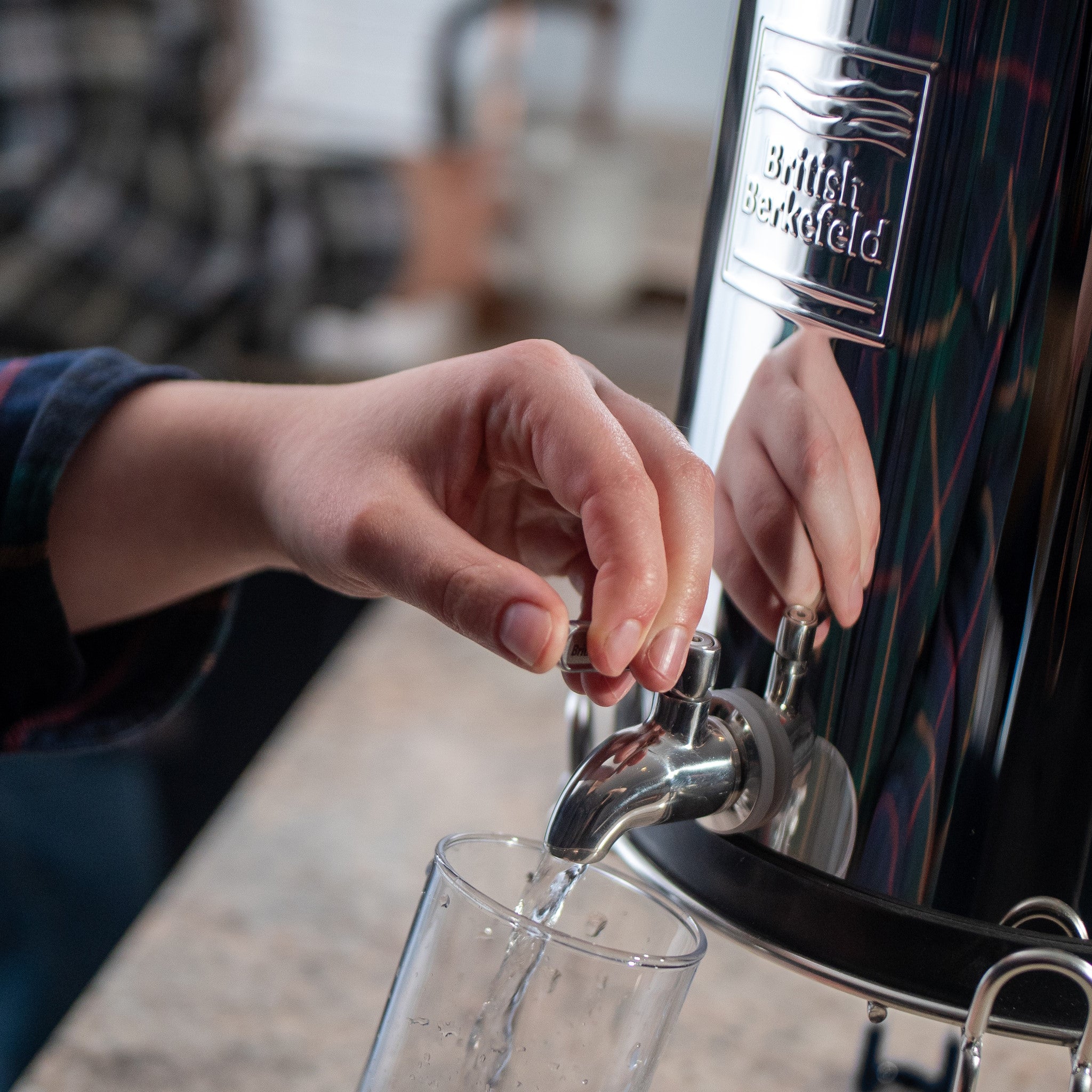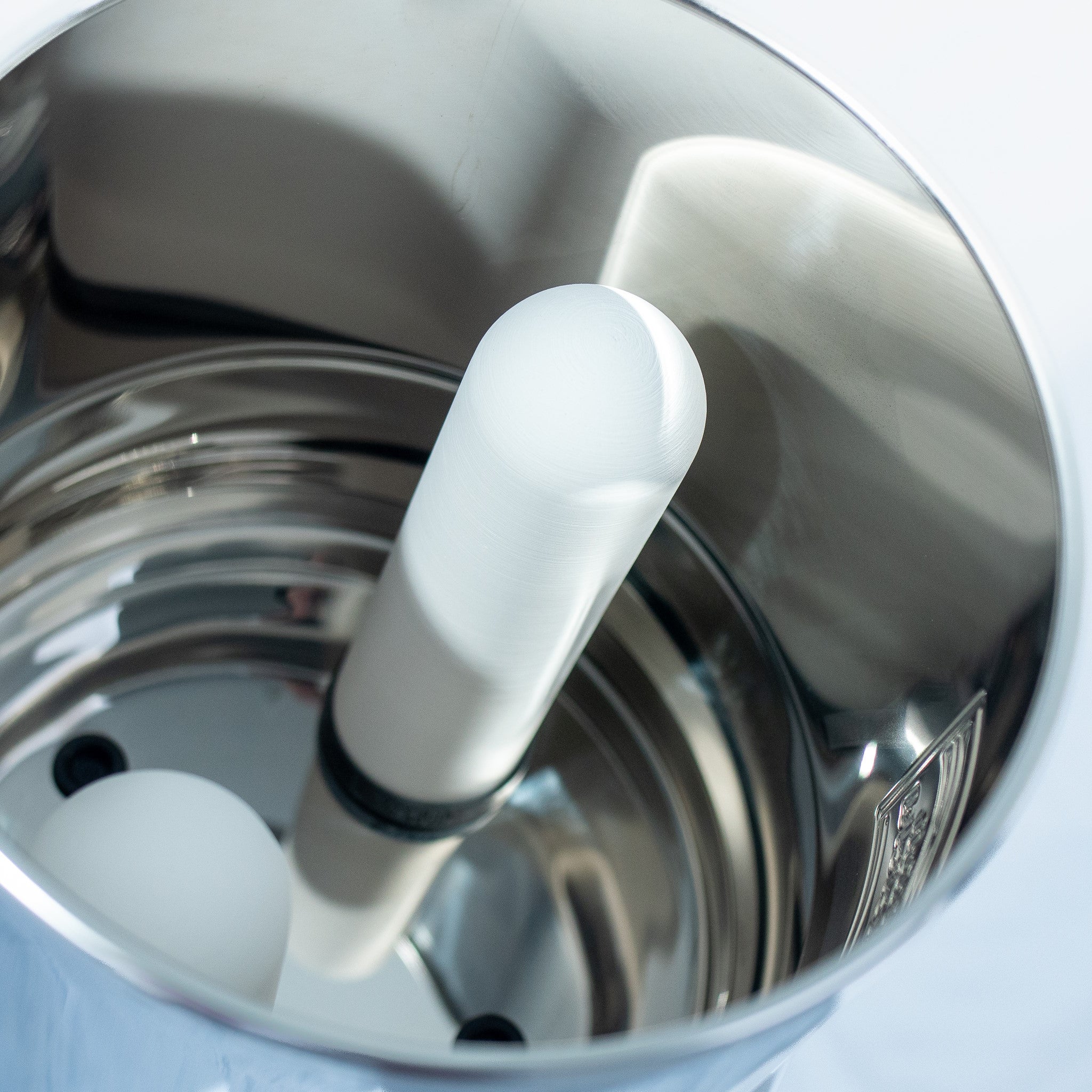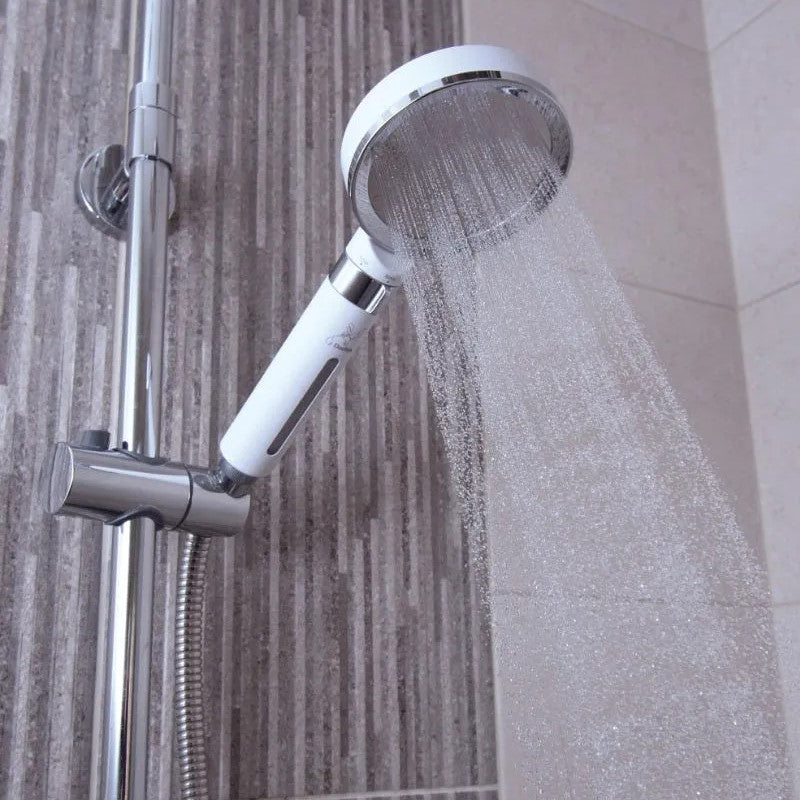Sterasyl® microfilter plus carbon block core and lead removal media |
Sterasyl® microfilter plus carbon block core & heavy metals with lead removal media |
|
Filtration Rating (% particulate filtration efficiency) Absolute (defined as > 99.99% ) Nominal (defined as >99.99%) |
0.9 micron 0.5 to 0.8 micron |
0.9 micron 0.5 to 0.8 micron |
Working Pressure (for pressure filter use) Minimum Maximum |
10 psi 125 psi |
10 psi 125 psi |
Working Parameters Working temperature range Working pH range Suitable for use in Gravity filter systems Recommended change frequency |
5 – 30 (°C) 5.5 – 9.5 No 6 months |
5 – 30 (°C) 5.5 – 9.5 No 6 months |
Flow Rate Unrestricted Flow at 3 Bar Pressure up to Litres per minute US gallons per minute To achieve maximum performance Litres per minute US gallons per minute |
3.3 0.9 1.9 0.5 |
3.3 0.9 1.9 0.5 |
Capacity Before replacement to guarantee performance Litres US gallons |
2300 600 |
2300 600 |
Quality Approval WRAS (Water Regulations Approval Scheme) Turbidity reduction |
Yes >98% |
Yes >98% |
Pathogenic Organisms Bacteria Removal* E. Coli / Shigella / Typhoid / Klebsiella Terrigena % Cyst Removal Cryptosporidium Giardia |
>99.99% >99.99% >99.99% |
>99.99% >99.99% >99.99% |
Trace Organics Removal Range of Pesticides+ Insecticides Lindane @ 0.1ppb presence Herbicides Atrazine @ 1.2ppb presence Phenols TCP @ 1.2ppb presence Polyaromatic Hydrocarbons PAHs @ 0.2ppb presence Trihalomethanes Chloroform @ 150ppb presence |
>85% >85% >50% >95% >50% |
>85% >85% >50% >95% >50% |
Enhanced Organics Removal Pharmaceuticals+ Lindane @ 2ppb presence Atrazine @ 9ppb presence Benzene @ 15ppb presence |
N/A N/A N/A |
Ave 70% Ave 90% Ave 87% |
Inorganics Removal Free Chlorine Removal 2ppm presence to NSF Class 1 Std 42 |
94.2% |
† >96% |
Monochloramine Reduction 3ppm presence 2ppm presence |
N/A N/A |
N/A Ave 64% |
Heavy Metals Removal Lead reduction pH6.5 @ 150ppb presence to NSF Std 53 Lead reduction pH8.5 @ 150ppb presence to NSF Std 53 Mercury reduction pH6.5 @ 6ppb presence Cadmium reduction pH 6.5 @ 30ppb presence |
97.3% 99.5% N/A N/A |
98.9% †99.1% Ave 90% Ave 95% |
Please note:
- This product is classed as a pesticidal device due to its filtration claims, individual state legislation may limit the availability of certain products, please check state law.
- +Internally generated test data.
- *Ceramics tested in HIS filter housing with a minimum of 5 log/100mls influent change.
Sterasyl® microfilter plus granular activated carbon and lead removal media |
Sterasyl® microfilter plus Fluoride and lead removal media with activated carbon |
|
Filtration Rating (% particulate filtration efficiency) Absolute (defined as > 99.99% ) Nominal (defined as >99.99%) |
0.9 micron 0.5 to 0.8 micron |
0.9 micron 0.5 to 0.8 micron |
Working Parameters Working temperature range Working pH range Suitable for use in Gravity filter systems Recommended change frequency |
5 – 30 (°C) 5.5 – 9.5 Yes 6 months |
5 – 30 (°C) 5.5 – 9.5 Yes 6 months |
Flow Rate To achieve maximum performance Litres per hour US gallons per hour |
1.2 under gravity 0.3 under gravity |
1.2 under gravity 0.3 under gravity |
Capacity Before replacement to guarantee performance |
After 6 months |
After 6 months |
Quality Approval WRAS (Water Regulations Approval Scheme) Turbidity reduction |
Yes >98% |
Yes >98% |
Pathogenic Organisms Bacteria Removal* E. Coli / Shigella / Typhoid / Klebsiella Terrigena % Cyst Removal Cryptosporidium Giardia |
>99.99% >99.99% >99.99% |
>99.99% >99.99% >99.99% |
Trace Organics Removal Range of Pesticides+ |
>95% |
N/A |
| PFOA & PFOS Combined removal efficiency 1.5ppb to less than or equal to 0.07ppb |
95% |
N/A |
Enhanced Organics Removal Pharmaceuticals+ Lindane @ 2ppb presence Atrazine @ 9ppb presence Benzene @ 15ppb presence |
>99.5% >99% 99.38% >99% |
NO DATA NO DATA NO DATA NO DATA |
Inorganics Removal Free Chlorine Removal 2ppm presence to NSF Class 1 Std 42 |
>99% under gravity |
Ave 97.2% |
Heavy Metals Removal Lead reduction pH 6.5 @ 150ppb presence to NSF Std 53 Mercury reduction pH 6.5 Ave 6ppb presence Arsenic reduction pH 6.5 Ave 47ppb presence Barium reduction pH 6.5 Ave 9834ppb presence Chromium reduction pH 6.5 Ave 339ppb presence Selenium reduction pH 6.5 |
Ave 95% N/A N/A N/A N/A N/A |
Ave 95% Ave 86.4% Ave 97.4% Ave 90% Ave 99.4% Ave 93.7% |
Please note:
- This product is classed as a pesticidal device due to its filtration claims, individual state legislation may limit the availability of certain products, please check state law.
- +Internally generated test data.
- ^Tested as Hexachlorobenzene


Certifications & Accreditations
Here are our certifications and accreditations, proudly showcasing our commitment to excellence and adherence to the highest industry standards. These credentials reflect our dedication to quality, safety, and continuous improvement, ensuring you receive the best possible service and products.
Compatible Water Systems
Our Ultra Sterasyl and Ultra Fluoride water filter cartridges will also fit most stainless-steel gravity water filter systems on the market. If you’re looking for an improved water experience, then a British Berkefeld ceramic candle will provide you with the ability to remove up to 99% of chlorine, significantly improving taste and odour. These filter elements also reduce common contaminants including heavy metals and bacteria.
| Competitor Systems | Model |
|---|---|
| Berkey® |
Travel Berkey® |
| Newton |
6 Litre |
| ProOne |
Big+ |
| Phoenix Gravity |
6 Litre |
| Purewell |
1.5 Gallons |
Can't find your system on our list? We're here to assist in determining compatibility. Your input helps us broaden our list of supported systems. If your filtration system model isn't listed, please email us at filtersales@doulton.com with the make, model, filter housing dimensions, and any other relevant specifications.
Test Data Explained
What does the term "Filtration Rating" refer to?
When considering a water filter, you'll probably note that each filter is equipped with a micron rating, as highlighted in the technical specifications.
According to Sciencenotes.org, a micron is a unit of length that is one millionth of a meter or 10-6 m. One micron is 1/26,000 of a inch. The micron is also known as a micrometer (American), micrometer (International Bureau of Weights and Measures), or by its abbreviation μm.
The micron or micrometer is used to describe sizes of very small objects. An object measuring just one micron across is only visible through magnification, such as a microscope, whereas objects with a thickness of 10 microns are barely perceptible without magnification. Typically, particles in the 50-to-60-micron range are visible to the naked human eye.
Here are a few examples:
- 1-10 μm - Length of Bacteria
- 17-181 μm - Diameter of human hair
- 70-180 μm – Thickness of a sheet of paper
So why is a filtration rating important for water filters?
The micron rating of a water filter denotes the size of the spaces between its filtering components, determining what contaminants can be filtered out. For instance, if your water contains particles sized at 5 µm and your entire home's water filter has a micron rating of 5 µm, it will efficiently remove those sediments and anything larger. However, if the sediment filter's micron rating exceeds 5 µm, these troublesome particles will evade filtration, entering your home and possibly posing risks to health and causing damage.
What are the different Water filter micron sizes and their filtering capabilities?
0.5-micron:
Referred to as ultra-fine filters, 0.5-micron filters excel at filtering most bacteria, cysts, protozoa, and other contaminants as small as 0.5 microns. They effectively target larger entities like Giardia lamblia and Cryptosporidium, known to cause gastrointestinal issues.
1-micron:
Filters with a 1-micron rating can successfully reduce numerous bacteria and parasites, including E. coli, Salmonella typhimurium, Shigella dysenteriae, and other certain viruses. The pore structure offers sufficient safeguarding against harmful contaminants commonly found in public drinking water sources.
5 microns:
Primarily designed for sediment removal, 5-micron filters are well-suited for whole-house filtration systems that require rapid filtration of large water volumes without compromising efficiency. While they provide some defense against larger organisms such as Giardia lamblia and cysts, they may not be effective against smaller pathogens like E. coli. Hence, it's advisable not to rely solely on 5-micron filters for combating bacterial contamination.
10 microns:
Although 10-micron filters may eliminate certain invisible particles from water, they are not effective against bacteria or viruses. Nevertheless, their minute size proves advantageous across various industries, from oil to chemical facilities, due to their extended filter life and slightly improved flow rates. However, like filters with lower micron ratings, 10-micron filters are prone to clogging.
Considering that many micro-organisms and cysts, while in their dormant stage, have a size exceeding 1 micron, Doulton® & British Berkefeld® ceramic water filters will effectively obstruct their passage through physical filtration.
What are Absolute and Nominal Micron Ratings?
Absolute Micron Rating:
What is meant by an absolute rating is the maximum size of particles that can pass through a filter. For instance, a 1-micron absolute filter is designed to block anything larger than 1 micron from passing through.
Nominal Micron Rating:
In contrast, a nominal filter provides more of an estimate than a precise assurance regarding the particle size that can pass through. This is because some of the pores or openings in the filter surface might be larger than the rated size, allowing a certain percentage of particles matching the micron rating to pass through.
What does Working Pressure mean in water filtration?
Water pressure occurs as water moves through various components such as filter systems and pipework. It enables us to determine the flow rate of water for our filters under the current working pressure.
What is the meaning of Flow Rate?
Water filtration equipment is usually dimensioned based on its flow rate, indicating the volume of water it can handle at any given moment. This measurement is commonly stated in litres or gallons per minute.
How to measure a Flow Rate?
Discovering your kitchen tap's flow rate is quite straightforward. All you require is a stopwatch and either a bucket or a one or two-litre jug! Simply open the cold water tap and measure the volume of water flowing through it in litres or gallons per minute.
What is the significance of quality approval and how is it explained?
Quality approval for water filters is of paramount importance for several reasons:
- Health and Safety: Water filters are designed to reduce impurities, contaminants, and pathogens from water, ensuring that it is safe for consumption. Quality approval ensures that the filter effectively reduces harmful substances, safeguarding public health and preventing waterborne diseases.
- Reliability: Approval from recognised quality control agencies or regulatory bodies verifies the reliability and performance of water filters. Consumers can trust that the filter will consistently deliver clean and safe drinking water as promised.
- Compliance: Quality approval often involves adherence to specific standards and regulations set by governmental or international organisations. Compliance with these standards ensures that the water filter meets minimum requirements for safety, quality, and environmental protection.
- Product Reputation: Approval from reputable organisations enhances the reputation of the water filter manufacturer. It demonstrates a commitment to quality and consumer safety.
- Legal Obligations: In many regions, manufacturers are legally required to obtain quality approvals
for products like water filters before they can be sold to consumers. - Performance Assurance: Quality approval typically involves rigorous testing procedures to evaluate the
performance of water filters under various conditions. This testing ensures that the filter operates effectively over its lifespan, providing consistent water quality. - You Can Be Confident: Knowing that a water filter has undergone quality approval. You can feel assured that the filter has been thoroughly tested and verified by independent or internal experts, reducing uncertainty about its effectiveness.
In summary, quality approval for water filters is significant for ensuring public health and safety, verifying product reliability and compliance, maintaining a positive reputation, fulfilling legal requirements, and inspiring consumer confidence.
What are Pathogenic Organisms?
A pathogenic organism is defined as an organism with the capacity to induce illness in a host. These organisms encompass various types such as bacteria, viruses, or cysts, all capable of instigating diseases like typhoid, cholera, and dysentery.
What are Trace Organics?
Trace organics refer to organic compounds present in minute concentrations in various substances, such as water, soil, air, and biological tissues. These compounds can originate from natural sources or be introduced into the environment through human activities such as industrial processes, agriculture, and waste disposal.
In environmental science and chemistry, the term "trace organics" often specifically refers to organic pollutants or contaminants that are found in very low concentrations but can still have significant impacts on ecosystems and human health due to their toxicity, persistence, and bioaccumulation properties. These compounds include pesticides, pharmaceuticals, industrial chemicals, and by-products of combustion.
What are Enhanced Organics?
Enhanced organics are organic materials that have been changed or improved to make them better for specific uses. This can involve chemical changes, physical alterations, surface treatments, nanotechnology, or biological modifications.
Organic contaminants fall into two primary categories: Volatile Organic Compounds (VOCs) and Total Organic Carbon (TOCs). VOCs consist of solvents, hydrocarbons, alcohols, and various industrial compounds. TOCs encompass all-organic carbon compounds, such as decaying plant and animal matter. Elevated TOC concentrations may be present in certain surface water sources (streams, rivers, lakes, reservoirs, etc.), but it tends to be less prevalent in groundwater sources.
Carbon filtration stands as an effective method for eliminating the majority of organic contaminants.
What are Inorganics?
Inorganic substances are chemicals without carbon, like ammonia, hydrogen sulphide, metals, and elements such as calcium.
The primary focus in most cases of removing inorganic contaminants involves reducing sediment or particles. This entails eliminating particles suspended in water or fluid before it can be utilised for its intended purpose. These particles may vary in visibility, ranging from those observable by the naked eye to those requiring magnification. Typically, particles smaller than 40 microns are imperceptible to most individuals (with 1 micron equating to one-thousandth of a millimetre or 1/1000 mm).
To provide a comparison of sizes, common particles and substances are outlined below:
- Dust: Up to 1 micron
- Cement dust: 3 to 4 microns
- Human red blood cell: 5 microns
- Pollen: 7 to 10 microns
- Silt: 10 to 75 microns
- Diameter of a human hair: 100 microns
- Sand: 75 to 1000 microns
What is Monochloramine?
Chloramination is a vital step in ensuring the safety and cleanliness of our drinking water. It involves the addition of chloramine, a compound containing both chlorine and ammonia, to effectively disinfect water and eliminate harmful germs. This method serves as an alternative to chlorination, offering its own set of advantages in water treatment processes.
Now, let's delve deeper into monochloramine, the specific type of chloramine used in drinking water disinfection. Monochloramine is meticulously mixed into water at precise levels to strike a balance: it effectively eliminates germs and pathogens, ensuring the water is safe for consumption, while still maintaining its safety for human consumption.
What sets monochloramine apart is its stability and long-lasting disinfection properties. Unlike free chlorine, which can dissipate relatively quickly, monochloramine persists in the water distribution system, providing a continuous barrier against microbial contaminants. This longevity ensures that water remains safe as it travels from the treatment plant to your tap.
Furthermore, monochloramine's effectiveness extends beyond just disinfection. It also helps control the formation of disinfection by-products (DBPs), which can pose health risks in their own right. By utilising monochloramine, water treatment facilities can mitigate these risks while maintaining the highest standards of water quality.
In summary, chloramination, particularly through the use of monochloramine, plays a crucial role in safeguarding the health and well-being of communities by ensuring access to clean, safe drinking water.










